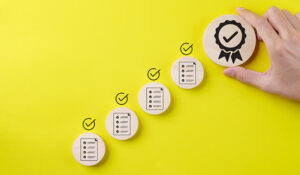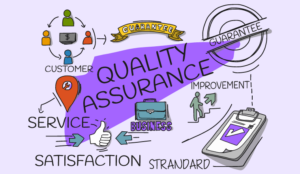Dick Bourke of Scorebuddy shares his advice for measuring customer experience through better contact centre Quality Assurance (QA).
Customer experience (CX) might be the most frequently used term in the customer service industry. Everyone is talking about the power of the customer, how important it is to make your customers happy, and what it takes to create loyal customers. It always comes back to improving the customer experience.
But what does that actually mean? Despite how trendy it is to talk about customer experience, few companies understand what it is. And that’s a significant problem because customer service is only a very small piece of the puzzle.
What is Customer Experience?
Every interaction on every touchpoint that your company has with a customer is part of the customer experience. It’s your entire business relationship from the moment someone first hears about your brand online, until they research your company, read your content, reach out to your sales team, and become a customer.
To truly understand the customer experience, you must think about the entire customer journey, starting with awareness through discovery, cultivation, advocacy, purchases, and service. And applying the right customer experience metric at the optimal point during that journey. It’s more than just providing great customer service; it’s providing customer satisfaction from end-to-end.
Every touchpoint is an opportunity for your organization to generate a positive or negative customer experience. And the more positive experiences you create, the better you’ll be able to retain customers and earn new business.
Importance of Customer Experience
The importance of good customer experiences cannot be denied as it’s the impression you leave with your customer resulting in the perception they are left with your brand.
It’s why “delivering great customer experience” has become the top strategic objective for most organizations, according to Bloomberg Businessweek.
Your entire organization will reap enormous rewards, including increased revenue, lower customer churn, greater employee satisfaction, and more.
- Brand Loyalty: When you provide good customer experiences, 86% of people will demonstrate brand loyalty (NewVoiceMedia), leading to 140% more money spent along with creating brand evangelists who will promote your brand (Harvard Business Review).
- Increased Revenue: According to research by American Express, 86% of customers are willing to pay more for a better experience.
- Product/Service Evangelism: 97% of customers consider reviews before making a purchase (Fan & Fuel), and consumers read an average of 10 online reviews before they commit to a local business (BrightLocal).
- Brand Differentiator: According to Gartner, 89% of companies compete primarily on the basis of customer experience.
- Customer Retention: Almost one in three customers (32%) will leave a brand they love after just one bad customer experience, explains PwC.
- Increased Customer Value: Emotionally attached customers are 25-110% more valuable in terms of revenue and profitability, according to Harvard Business Review.
Customer experiences don’t just matter; they are critical to your organization’s success. So, it should be no surprise that figuring out how to improve the customer experience is one of the main trends in 2020.
2020 Customer Experience Trends
Based on a 2020 Digital Marketing Trends Report by Econsultancy and Adobe, customer experience is the most exciting business opportunity in the coming year.
Customer experience is also set to become the number one brand differentiator now and in the future—more so than products or services, according to a Walker study.
So, it’s essential to create your buyers personas and anticipate their pain points, solve their problems and create a positive relationship with your customers. Consistently asking for feedback and ways for improvement.
Unfortunately, though customer experience is a high priority, many companies are failing to live up to expectations.
According to a recent Temkin Group study, companies scoring a “good” or “excellent” experience rating fell from 45% in 2017 to only 38% in 2018.
To overcome these failings, what are some of the customer experience trends predicted for 2020?
Trend #1 – Emotional Intelligence
The ability to recognize and regulate the emotions of yourself and others is key to quality customer experiences.
According to Haravard Business School professor Gerald Zaltman, 95 percent of purchasing decisions are made subconsciously (emotionally), meaning that your business relies on emotional intelligence for success.
Customers who feel they have an emotional connection to a brand become loyal advocates, recommend brands to their friends and family, and make repeat purchases.
In contrast, customers who experience a negative experience are likely to share their experiences with friends, colleagues or even broadcasting that experience on social channels which can have far reaching potential to a vast audience.
Trend #2 – Services Compared to Products
Companies need to start reimaging their consumers and their business practices. The reality is that consumerism is dying.
Instead, people are spending more money on experiences over things, so services are becoming more and more valuable.
Even if you have a product, what will differentiate you is competing on experience such as personalized service, teaching customers, creating useful quality content and building communities for your audience.
Trend #3 – Company Culture is Critical
Good customer experiences start within your company culture.
A strong culture that is focused on teamwork, employee engagement, transparency, and bettering the community will improve the customer experience.
It’s an often-overlooked piece of the strategy, but by rebranding your organization to be culture-focused, it will result in more satisfied customers along with employees.
What Customer Experience Metrics Matter?
To begin to improve the customer experience, you have to start with measuring customer experience. And there are a few metrics that are essential to success.
Net Promoter Score (NPS)
NPS is one of the gold standard metrics for measuring customer experience. It helps you assess customer loyalty by asking your customers one simple question: “On a scale of 0 – 10, how likely are you to recommend the company or agent you spoke with to a colleague or friend? Why?”
A 0 on the scale means the customer is extremely unlikely to recommend you, and a 10 means they are extremely likely to recommend.
From there, your company receives a quantitative score that divides your customers into Detractors (scores of 0-6), Passives (scores 7-8), and Promoters (9-10). You can calculate net promoter score by subtracting the percentage of detractors from promoters.
Customer Satisfaction (CSAT)
Customer satisfaction (CSAT) is another common KPI for customer experience. It’s a score you receive from a CSAT survey that asks your customers to rate how satisfied they were with their experience based on a survey scale, which can be 1-3, 1-5, 1-7, or 1-10.
It’s a short, intuitive, and simple metric that helps you figure out how satisfied your customers are with your organization.
The issue is that “satisfied” is a very subjective word and means different things to different people.
On top of that, CSAT provides just one value without any explanation, and so can be difficult to improve upon. A general rule of thumb is to send a CSAT survey within 30 minutes of a product or service has been used.
Customer Journey Analytics
As we mentioned above, customer experience is not just about customer service; it covers the entire customer journey from beginning to end. As such, you must use different key performance indicators and CX metrics to match each stage in the journey.
Here are a few examples:
- Customer Churn Rate: Over time, you’ll need to measure how many customers are lost during a specific time frame to determine how many customers stop buying from your business. This can be calculated by subtracting customers at the end of a timeframe from the start of the timeframe and dividing it by the customers at the start of a timeframe.
- Customer Effort Score: How much effort is required by your customer to handle the interaction. This survey question might ask something like: “How much effort did it take to resolve your problem?”
- Average Resolution Time: How long did it take the customer to resolve their issue, starting with the moment the issue is brought to your attention? A shorter resolution time equates to higher levels of customer satisfaction. This can be calculated by the sum of all times to resolution in a timeframe divided by the total number of cases solved in that timeframe.
- First Contact Resolution Rate (FCR): Customers are more satisfied with their experience when their problem, issue, or question is resolved in the first attempt. This ties into the customer effort score, with a high FCR score leading to better customer experiences. This can be calculated by dividing the number of resolved incidents on first contact by the total number of incidents.
How to Measure Customer Experience
Now that you know some of the essential customer experience metrics you need to measure, you need a strategic QA framework. This will be used to set your organization’s customer-centric goals and to determine how you can move the needle forward.
The ideal QA framework is structured to analyze, interpret, and share customer experience data in a way that results in action. You must take into account all critical influences—the customer, the business, the client, etc.—and then set metrics (as outlined above), measure, and collaborate as a whole.
There are three steps to get started:
- First, get to know your customers: their needs and expectations. By determining what they value, you can outline what is most important at each touchpoint in the customer journey.
- Next, identify all customer interaction points throughout the customer journey. Each touchpoint should have associated metrics to measure the customer experience.
- Finally, build a customer experience measurement scorecard to identify the quality of the customer experience at critical points, so you can improve your results strategically.
The Benefits of Using QA Tools
The most effective customer experiences take place when your employees undertake personal initiative to provide high levels of customer satisfaction.
That’s why it’s best practice to give your employees the power to take customer experience into their own hands.
By providing them with scorecards to grade their efforts, you can help them understand how they’re performing and how they can support the company’s overall goals.
QA tools help you monitor the customer experience through all interactions at every touchpoint.
You can set agent performance metrics for every interaction and use self-evaluation to determine how well each step in the customer’s journey went.
QA tools can help you measure:
- How well your agents recognized your customer’s emotional needs and mood.
- How well your agents provided the customer with their desired outcome.
- Whether or not the customer’s perception was changed positively or negatively by the end of the encounter.
Based on how your employees fill in the scorecard, you can gather a baseline metric for the customer experience.
From there, you can recognize top performers, set up ongoing coaching, initiate role-playing for better training, leverage positive outcomes, and more.
Final Thoughts
Learning how to improve the customer experience is not an easy or quick process. It takes a careful review of the entire customer journey and every touchpoint to figure out what you’re doing well and where you’re failing.

Dick Bourke
The key is to take the customer experience seriously and do what’s necessary to make changes that have a big impact.
By measuring the right customer experience metrics and implementing QA tools, you can take an in-depth look at the customer experience you’re delivering and strive to make improvements in your processes.
This blog post has been re-published by kind permission of Scorebuddy – View the Original Article
For more information about Scorebuddy - visit the Scorebuddy Website
Call Centre Helper is not responsible for the content of these guest blog posts. The opinions expressed in this article are those of the author, and do not necessarily reflect those of Call Centre Helper.
Author: Scorebuddy
Published On: 13th Mar 2020 - Last modified: 18th Dec 2023
Read more about - Guest Blogs, Dick Bourke, Scorebuddy






 Scorebuddy is quality assurance solution for scoring customer service calls, emails and web chat. It is a dedicated, stand-alone staff scoring system based in the cloud, requiring no integration.
Scorebuddy is quality assurance solution for scoring customer service calls, emails and web chat. It is a dedicated, stand-alone staff scoring system based in the cloud, requiring no integration. 





























